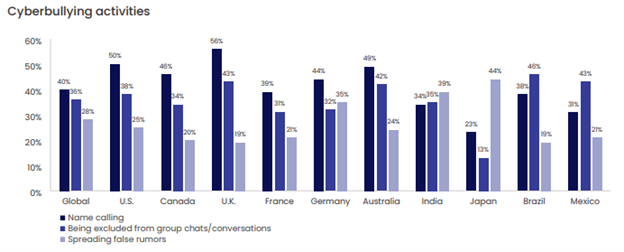
More than half of children say that a cyberbully targeted them online.
That disquieting stat comes from our recent global research on cyberbullying. Overall, 57% of children said they were cyberbullied during the school year. Meanwhile, many parents remain in the dark. Only 42% of parents worldwide said they were aware that their child was bullied online. A distinct awareness gap.
And in the wake of those attacks, the risk of emotional and even physical harm follows.
That’s why talking about cyberbullying is so vital. It acknowledges that cyberbullying remains a fact of life for children today. Moreover, it gives families the tools to spot it—and help heal any harm that comes along with it.
Here, we’ll share some points that can help spark that conversation at home. We’ll look at what cyberbullying is, its signs, its trends, and the steps you can take if someone you know is getting bullied online.
What is cyberbullying?
“I know it when I see it” only goes so far when it comes to spotting cyberbullying. A clear definition helps far more than that. StopBullying.gov defines it as:
… [B]ullying that takes place over digital devices like cell phones, computers, and tablets. Cyberbullying can occur through SMS, text, and apps, or online in social media, forums, or gaming where people can view, participate in, or share content. Cyberbullying includes sending, posting, or sharing negative, harmful, false, or mean content about someone else. It can include sharing personal or private information about someone else causing embarrassment or humiliation. Some cyberbullying crosses the line into unlawful or criminal behavior.
Moreover, it can also include sending explicit images or messages and exclusion from group chats and conversations as well. Exclusion is an important point and sometimes gets overlooked in conversations about cyberbullying. As we’ll see, children reported it as one of the top three forms of cyberbullying they’ve experienced.
What are the signs of cyberbullying?
It’s no secret that children hide their online activities from their parents. Our research puts a number to that. More than half of children (59%) take some action to hide what they’re up to online. As an adult, that means you might not see the offending text, post, or content yourself. More likely, you will spot a change in behavior.
Sadness and depression commonly appear in victims. This can manifest itself in several ways, including the following signs as called out by WebMD:
- The child becomes noticeably upset after being online or on their phone.
- The child doesn’t engage with family or friends.
- The child doesn’t want to participate in activities they typically enjoy.
- Their school grades have unexpectedly declined.
- They don’t want to go to school or the playground.
- Increasingly saying they’re too sick to do anything else.
In all, spotting cyberbullying involves more than keeping an eye on a child’s phone. Importantly, it calls for keeping an eye on the child.
A quick look at cyberbullying stats
With an understanding of what cyberbullying is, let’s look at what’s happening online.
Based on our research, children reported that name-calling, exclusion, and rumormongering were the top three forms of cyberbullying.

Also making troubling appearances in the list, by percentage:
- Parents reporting racially motivated cyberbullying, 24%
- Children reporting stalking, harassment, and physical threats online, 15%
- Children reporting sexual harassment online, 13%
Also uncovered in our research, sometimes the cyberbully is our own child. Among children worldwide, 19% admitted to cyberbullying another child. However, follow-up questions revealed that 53% of children admitted to one or more acts that constitute cyberbullying. Among the top responses:
- Making a joke at someone else’s expense, 22%
- Name calling, 18%
- Excluding someone from a chat or conversation, 15%
- “Burned” or teased someone, 12%
With that, some children indeed cyberbully others yet remain unaware that they’re doing it. Note that exclusion appears again as one of the top three offenders, such as where children shut out others in group texts and chats.
The toll that cyberbullying takes
Even in its mildest of forms, cyberbullying can lead to emotional harm. Potentially to physical harm as well.
For one, a victim of cyberbullying will likely never view the internet the same way again. An attack on a person’s digital identity is an attack on their personal identity. Both of those identities can suffer.
Children seem to agree. More than one in three (34%) said that they have deleted a social media account to avoid cyberbullying. Nearly as many children hide the hurt. Only 33% said that they sought help with cyberbullying.
This can impact mental health. Faced with a constant barrage of insults and harassment, victims of cyberbullying often grapple with negative thoughts, insecurity, and even depression after their attacks occur. In fact, according to research conducted at Penn State University, 30% of individuals who were cyberbullied turned toward self-harming behaviors and began having suicidal thoughts.
In response, 18% of parents said that they turned to therapy for support when their child was cyberbullied. Another 11% said that they took the further step of changing their child’s school because of cyberbullying. Indeed, cyberbullying can leave an indelible mark on the lives of victims and their families.
Six steps you can take if your child is being harassed online
Whatever form it takes, the best way to deal with cyberbullying is to deal with it immediately.
- Don’t respond to it. While you might want to strike back with a message or post of your own, don’t. This might only escalate the situation or, worse yet, make you look like the instigator. In all, responding will only do more harm than good.
- Document everything. Grab screenshots of the messages, posts, texts, photos, or whatever was involved in the harassment. Include the screenname of the person behind it, along with a time and date. This will help you document a timeline of the harassment.
- Report it. Depending on the context and situation, you have options here. For example, this might be a matter that you want to report to your child’s school. Likewise, harassment almost always violates the terms of service on websites, services, and apps. You might be able to flag a negative post to get it removed and other sites, services, and apps might have other avenues to report harassment. Use them. And get that content taken down if it is posted publicly.
- Determine if it breaks the law where you live. Of course, laws will vary based on your nation, state, or province, yet anti-harassment laws are in the books—not to mention defamation, slander, and libel laws. A search for governmental resources on cyberbullying and online harassment can offer a good start, and you can consult with licensed counsel in your area if you think that the harassment you’ve encountered might have crossed a legal line.
- Monitor. Harassment is often persistent. Keep an eye out for more of it and follow the same steps here as needed.
- Contact your local emergency number if you’re in immediate danger. If you fear for the wellbeing of your family or home, make the call and get help.
Getting help with cyberbullying—mental health resources you can turn to
Harassment and threats in their more extreme expressions can leave emotional scars. Victims might need support in the wake of them, possibly from a professional. You and your judgment will know what’s best here, yet given the harm it can cause, keep an eye for signs of lasting effects such as the ones mentioned above.
If you’re unsure of where to turn, you have plenty of resources available that can help start the process. In the U.S., the Department of Health & Human Services has a list of resources available for victims and their families. Likewise, the Canadian government website hosts a list of similar mental health resources, and in the UK the NHS hosts a list of resources as well.




